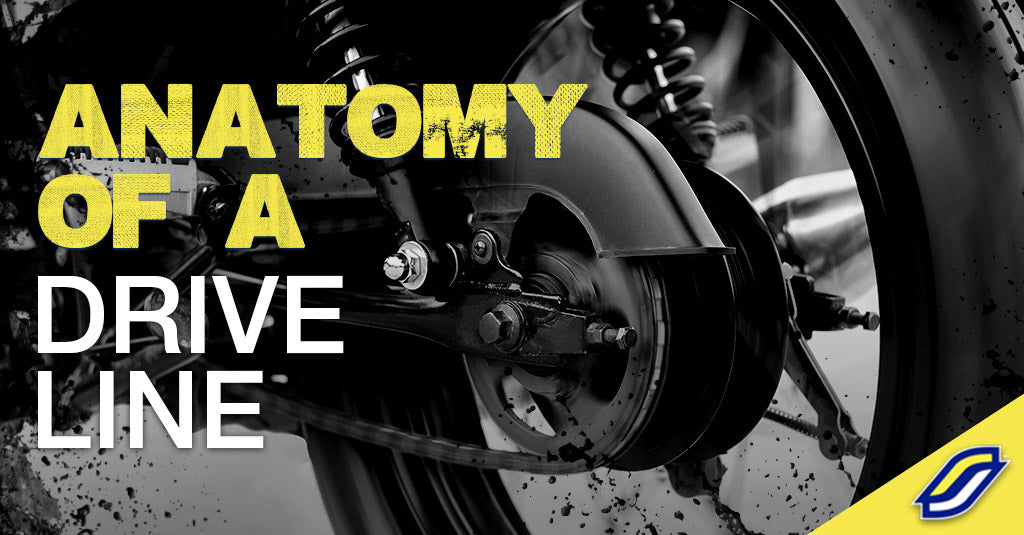
The motorcycle final drive is perhaps the most often overlooked system, yet it gives us as riders the opportunity to tailor the performance of our machine precisely to our own riding style.
What’s a drivetrain? And how do I get on board?
The drivetrain is a series of mechanical components that drive the motorcycle forward, beginning with power creation and ending with delivery of that power to the rear wheel.
Comprised of the engine that generates power and a transmission that enables the rider to apply that power in a usable way, this “primary drive” system is then connected to the “final drive” that ultimately transfers the spinning muscle from the gear box back to the rear wheel.
Simple enough, right?
Well, not quite. Getting all of that power to the ground in an appropriate way for specific riding styles, speeds and environments requires careful specification of gear reduction ratios throughout the system. Fortunately, those calculations have been done for us by the smart people at the factories who actually know how to apply all of those mathematic principles the rest of us forgot the instant we left school. Engineers have created the optimal gear reduction systems for each distinct type of motorcycle, from trail bikes and ATVs that casually meander through forests, to motocross bikes that sprint from corner to corner, to sportbikes that demand high-speed performance, to touring bikes that call for lower cruising RPMs.
That’s great! Or is it?
Motorcycle engineers are forced to design motorcycle drivetrains for the cross section of riders of each bike type. And, while they do a remarkable job of finding the best possible compromise, it still can be a little like wearing a “one size fits all” pair of pants instead of a tailored suit. Fortunately, that’s where the final drive system comes into play.
The final drive. The beginning of possibilities.
Connecting all of that awesome power to the ground is done in one of three ways: through sprockets and roller chain, pulleys and belt, or via a driveshaft. For this discussion, we’re going to focus on the sprocket and chain setup since it is the one configuration that allows for relatively simple tuning of final drive ratios for better performance.
Just as the tailor makes fine adjustments to clothing to fit you precisely, the chain and sprocket final drive system gives you the ability to match your machine to your riding style, personal preferences and even to a specific riding environment. If you gain or lose a little weight, the tailor lets out or takes in your pants accordingly. If you need a little more acceleration from your bike, you can tailor your final drive system by gearing down. Want more top end speed? Gear up. In order to do that, we must understand a little more about the components of the sprocket and chain final drive system.
Sprockets. Something to sink your teeth into.
The Countershaft Sprocket—This smallish chain wheel lives on the outside of the transmission case, attached to the business end of the gear box’s output shaft (the rotating shaft that spins at a speed determined by gear selection). This sprocket is the first stage of transferring power from the engine and transmission to the rear wheel. How effectively it does that depends upon its size, measured by the number of chain-engaging “teeth” it has. A larger countershaft sprocket equates to higher road speed but less responsiveness at lower speeds. A smaller countershaft sprocket means snappier acceleration, but compromises top-end performance. Changing countershaft sprockets, even by one tooth, can have a significant impact on performance. Which takes us to …
The Rear Wheel Sprocket—Fastened directly to the hub of the rear wheel, this larger toothed sprocket is, quite literally, where the rubber meets the road. Like the countershaft sprocket, rear wheel sprockets are available in a number of different sizes, defined by number of teeth. Subtle adjustments to performance of the motorcycle can most easily be made by switching to a rear sprocket that is one tooth larger or smaller. A larger rear sprocket provides more acceleration but less top-end speed. A smaller rear sprocket contributes to higher top-end speed (and lower RPMs at cruising speed for road-going riders), but gives up acceleration.
The Roller Chain—Connecting the countershaft sprocket to the rear sprocket is the roller chain, which is available in either a sealed ring or non-sealed ring design (more on that in an upcoming blog). The chain is comprised of individual links that loop around the sprockets and engage the teeth. It’s not only a lightweight and highly efficient means of transferring power, it also gives the rider options. Unlike other final drive systems, the roller chain length can be easily changed, making it relatively quick and easy to swap out sprockets and tailor the final drive ratio.
Now that we’ve got the wheels turning…
How do we determine the best combination for ideal gearing on our own machine? We’ll get into that in an upcoming installment of this blog. In the meantime, explore the different sprocket and chain options available for your bike by visiting www.sunstar-braking.com. You’ll find the OEM configuration listed as well as the available options to enhance performance. Have questions or can’t wait for the next installment to gear up or gear down? Don’t hesitate to reach out to us with questions by calling (937) 743-9049 [x1334].

